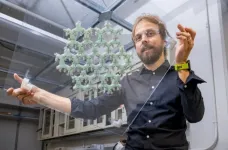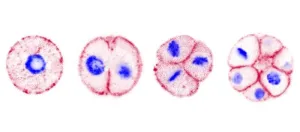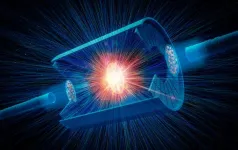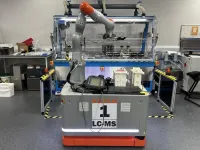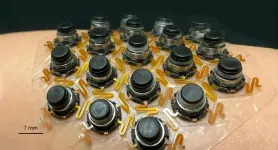(Press-News.org) The human brain is an astonishing organ, as any neuroscientist can attest. And its ability to collect, store, analyze and use information is intriguing to physicists, engineers and computer scientists, too.
Benjamin Jungfleisch, associate professor of physics at the University of Delaware, is among them.
Jungfleisch, who joined UD’s faculty in 2018, is an expert in magnon spintronics. He uses lasers to explore the dynamics of magnetic nanostructures — tiny magnets that can be used to store and steer information through a circuit.
A primary focus of his work now is finding brain-inspired ways to develop low-energy computing, using interacting nanomagnets as the command center.
Neurons are the brain’s information processors, with electrical and chemical signals carrying information between neurons. In a similar way, magnons — the fundamental quantum excitations that make up “magnetic waves” or “spin waves” in a magnetic system — perform a similar process through arrays of magnetic nanostructures, carrying and processing information in ways that could lead to faster, more energy-efficient processing and even artificial intelligence (AI) devices.
This addresses a critical need, especially now as the energy consumption of AI is skyrocketing. AI has extraordinary potential for our world. But its complexity requires intensive computing power and an ever-increasing number of data centers to manage and meet the computational demand. Without innovative solutions, energy will be an increasing problem for society, industry and the climate.
The National Science Foundation has recognized the significance of Jungfleisch’s work with a 2024 CAREER Award, a five-year grant worth just over $798,000, to support his research team’s efforts to develop low-power computing and processing methods using these magnetic nanostructures. The project also is supported by the Established Program to Stimulate Competitive Research (EPSCoR).
Jungfleisch’s primary collaborator — Jack Gartside, a physicist at Imperial College in London — had a breakthrough in 2022, using effects Jungfleisch discovered in 2016 related to this hysteretic behavior and realized the network could be trained and predictions about the future could be made.
In the future, Jungfleisch said, training cycles that now require two or three hours to complete could take minutes, using novel phenomena such as spin torque.
Learning about these interactions and how to manipulate and tune them for specific purposes is critical to Jungfleisch’s CAREER project, which will address four important challenges:
Controlling magnons in two-dimensional arrays of nanomagnets
Manipulating magnon-magnon interactions
Increasing knowledge of the dynamics in magnetic nanostructures
Demonstrating these next-generation neuromorphic concepts experimentally
Two recent publications in Nature Communications by Jungfleisch and collaborators explain progress made recently in magnon-magnon coupling and nonlinear dynamics.
Three-dimensional work is underway and advancing quickly, Jungfleisch said.
The more recent publication describes a three-dimensional nanomagnetic structure that improves performance over two-dimensional arrays and requires simple fabrication and measurement techniques that are widely available. Among the advances are the demonstration that a three-dimensional magnonic material can be stacked with independently programmable magnetic nanostructured systems.
“You get many more states in your system and a much smaller footprint,” Jungfleisch said. “Storing more information in these networks is easier since you have more space available. Who doesn’t want more neurons?”
You also get more flexibility.
“This gives you a lot of reconfigurability,” Jungfleisch said. “You can change the dynamics of the synaptic behavior as well as the memory.”
Nonlinear dynamics also emerge as interesting phenomena in these networks. For example, Jungfleisch found that one magnon can split into two or two magnons can merge into one in these structures. This provides the foundation for parallel computing and information processing.
“We’ll use this phenomenon to improve the function of the neuromorphics,” he said.
Many questions remain, including how to create and manage randomness and disorder in these systems.
During his upcoming sabbatical, Jungfleisch plans to continue his work with research groups in Germany and India.
And later, as part of his CAREER Award project, he plans to develop a five-week introductory course on magnetism and electricity for adults in UD’s Osher Lifelong Learning Institute and create a wave machine demonstration that would make spin waves visible using an infrared camera. He also wants to develop a wave machine demonstration — using barbeque skewers, duct tape and gummy bears — that would be accessible to students with various disabilities. That device would be available for loan to science teachers in local middle schools and high schools.
Jungfleisch works with nanomagnetic arrays, which can be compared to the brain’s neural networks, the pathways used to move signals along. Magnon connections are akin to the “synapses” that transmit signals along specific circuits.
“These arrays of interacting nanomagnets are essentially just tiny bar magnets,” Jungfleisch said, “like the ones you have on your fridge and the ones children play with. They have a north and a south pole. And if you make them very small — on the nanometer scale — you can pattern them with state-of-the-art lithography, which we have available here.”
When Jungfleisch says “tiny,” he is talking about things you cannot see with your eyes. Nanoscale structures are measured in nanometers. It takes more than 25 million nanometers to make one inch. Much of the work is done in UD’s Nanofabrication Facility, headquartered in the Patrick T. Harker Interdisciplinary Science and Engineering (ISE) Laboratory.
“You can make lattices out of them and they interact,” he said. “They can store information — very similar to what the neurons do in our brain. And the neurons are all connected in a network. So we place these nanomagnets in a network and they feel each other.”
Traditional computers use a processor and memory.
“Data is constantly shuffled between the two and it’s highly inefficient,” Jungfleisch said.
Devices using interacting nanomagnets offer multiple advantages.
“These structures can do it all,” he said. “We do not need electrons, because we use magnetic excitations. And second, we can do processing and storage at the same time in the same unit.
“There are specific tasks such as artificial intelligence where this may be useful — what we do with ChatGPT, for example, or recently emerging chatbots for creating images.”
These nanomagnet networks can be trained, Jungfleisch said. They keep a history and remember the state they are in, but they also need to be susceptible to change and retraining — neuromorphic changes, they are called.
END
Grant supports finding brain-inspired ways to develop low-energy computing
University of Delaware professor wins NSF CAREER Award that will assist with development of faster processing and artificial intelligence (AI) devices
2024-11-06
ELSE PRESS RELEASES FROM THIS DATE:
People engaging in self-harm find support on Reddit. But is that community helping them?
2024-11-06
A new study from the University of Georgia suggests people posting in Reddit’s r/selfharm community are likely seeking support for negative emotions.
While sharing traumatic events online can be cathartic, the researchers caution that subreddits can’t provide the same type of mental health help and support face-to-face interactions and professional help can.
“We don’t know the accuracy of the information that’s being shared in these communities about nonsuicidal self-injury,” ...
The egg or the chicken? An ancient unicellular says egg!
2024-11-06
Chromosphaera perkinsii is a single-celled species discovered in 2017 in marine sediments around Hawaii. The first signs of its presence on Earth have been dated at over a billion years, well before the appearance of the first animals. A team from the University of Geneva (UNIGE) has observed that this species forms multicellular structures that bear striking similarities to animal embryos. These observations suggest that the genetic programmes responsible for embryonic development were already present before the emergence of animal life, ...
Coping and resilience aids parents of disabled children, study says
2024-11-06
OXFORD, Miss. – For parents of children with disabilities, finding time to focus on themselves may be difficult. However, a new study finds that the right coping strategies and resilience can significantly help manage the challenges of raising children with special needs.
That is the key finding from research published in the International Journal of Developmental Disabilities that studied families with neurodevelopmentally disabled children in Ghana to see what helps parents cultivate healthy, happy lives for themselves and their children.
“Our main interest ...
Lupus Research Alliance announces inaugural recipients of Translational Bridge Award
2024-11-06
New York, NY. November 6, 2024. The Lupus Research Alliance (LRA) is excited to announce the first-ever recipients of the Translational Bridge Award (TBA), established this year to accelerate the translation of groundbreaking research into potential treatments and diagnostics for lupus. The award aims to propel high-potential projects from LRA-funded foundational discoveries with strong commercialization potential or an opportunity for clinical evaluation. Five exceptional researchers have been awarded the 2024 Translational Bridge Award to tackle pressing ...
Brain stars hold our memories
2024-11-06
A study published in Nature by researchers at Baylor College of Medicine changes the way we understand memory. Until now, memories have been explained by the activity of brain cells called neurons that respond to learning events and control memory recall. The Baylor team expanded this theory by showing that non-neuronal cell types in the brain called astrocytes – star-shaped cells – also store memories and work in concert with groups of neurons called engrams to regulate storage and retrieval of memories.
“The prevailing idea is that the formation and recall of memories only involves neuronal engrams that are activated by certain ...
Imaging nuclear shapes by smashing them to smithereens
2024-11-06
UPTON, N.Y. — Scientists have demonstrated a new way to use high-energy particle smashups at the Relativistic Heavy Ion Collider (RHIC) — a U.S. Department of Energy (DOE) Office of Science user facility for nuclear physics research at DOE’s Brookhaven National Laboratory — to reveal subtle details about the shapes of atomic nuclei. The method, described in a paper just published in Nature, is complementary to lower energy techniques for determining nuclear structure. It will add depth to scientists’ understanding of the nuclei that make up the ...
AI-driven mobile robots team up to tackle chemical synthesis
2024-11-06
Researchers at the University of Liverpool have developed AI-driven mobile robots that can carry out chemical synthesis research with axtraordinairy efficiency.
In a study publishing in the journal Nature, researchers show how mobile robots that use AI logic to make decisions were able to perform exploratory chemistry research tasks to the same level as humans, but much faster.
The 1.75-meter-tall mobile robots were designed by the Liverpool team to tackle three primary problems in exploratory chemistry: performing the reactions, ...
New haptic patch transmits complexity of touch to the skin
2024-11-06
A Northwestern University-led team of engineers has developed a new type of wearable device that stimulates skin to deliver various complex sensations.
The thin, flexible device gently adheres to the skin, providing more realistic and immersive sensory experiences. Although the new device obviously lends itself to gaming and virtual reality (VR), the researchers also envision applications in healthcare. For example, the device could help people with visual impairments “feel” their surroundings or give feedback to people with prosthetic limbs.
The ...
Safety of simultaneous vs sequential mRNA COVID-19 and inactivated influenza vaccines
2024-11-06
About The Study: In this randomized clinical trial assessing simultaneous vs sequential administration of mRNA COVID-19 and inactivated influenza vaccines, reactogenicity was comparable in both groups. These findings support the option of simultaneous administration of these vaccines.
Corresponding Author: To contact the corresponding author, Emmanuel B. Walter, MD, MPH, email chip.walter@duke.edu.
To access the embargoed study: Visit our For The Media website at this link https://media.jamanetwork.com/
(doi:10.1001/jamanetworkopen.2024.43166)
Editor’s Note: Please see the article for additional information, including other ...
Long-term risk of autoimmune and autoinflammatory connective tissue disorders following COVID-19
2024-11-06
About The Study: This retrospective cohort study with an extended follow-up period found associations between COVID-19 and the long-term risk of various autoimmune and autoinflammatory connective tissue disorders. Long-term monitoring and care of patients is crucial after COVID-19, considering demographic factors, disease severity, and vaccination status, to mitigate these risks.
Corresponding Author: To contact the corresponding author, Solam Lee, MD, PhD, email solam@yonsei.ac.kr.
To access the embargoed study: Visit our For The Media website ...
LAST 30 PRESS RELEASES:
Air pollution exposure and birth weight
Obstructive sleep apnea risk and mental health conditions among older adults
How talking slows eye movements behind the wheel
The Ceramic Society of Japan’s Oxoate Ceramics Research Association launches new international book project
Heart-brain connection: international study reveals the role of the vagus nerve in keeping the heart young
Researchers identify Rb1 as a predictive biomarker for a new therapeutic strategy in some breast cancers
Survey reveals ethical gaps slowing AI adoption in pediatric surgery
Stimulant ADHD medications work differently than thought
AI overestimates how smart people are, according to HSE economists
HSE researchers create genome-wide map of quadruplexes
Scientists boost cell "powerhouses" to burn more calories
Automatic label checking: The missing step in making reliable medical AI
Low daily alcohol intake linked to 50% heightened mouth cancer risk in India
American Meteorological Society announces Rick Spinrad as 2026 President-Elect
Biomass-based carbon capture spotlighted in newly released global climate webinar recording
Illuminating invisible nano pollutants: advanced bioimaging tracks the full journey of emerging nanoscale contaminants in living systems
How does age affect recovery from spinal cord injury?
Novel AI tool offers prognosis for patients with head and neck cancer
Fathers’ microplastic exposure tied to their children’s metabolic problems
Research validates laboratory model for studying high-grade serous ovarian cancer
SIR 2026 delivers transformative breakthroughs in minimally invasive medicine to improve patient care
Stem Cell Reports most downloaded papers of 2025 highlight the breadth and impact of stem cell research
Oxford-led study estimates NHS spends around 3% of its primary and secondary care budget on the health impacts of heat and cold in England
A researcher’s long quest leads to a smart composite breakthrough
Urban wild bees act as “microbial sensors” of city health.
New study finds where you live affects recovery after a hip fracture
Forecasting the impact of fully automated vehicle adoption on US road traffic injuries
Alcohol-related hospitalizations from 2016 to 2022
Semaglutide and hospitalizations in patients with obesity and established cardiovascular disease
Researchers ‘listen in’ to embryo-mother interactions during implantation using a culture system replicating the womb lining
[Press-News.org] Grant supports finding brain-inspired ways to develop low-energy computingUniversity of Delaware professor wins NSF CAREER Award that will assist with development of faster processing and artificial intelligence (AI) devices
